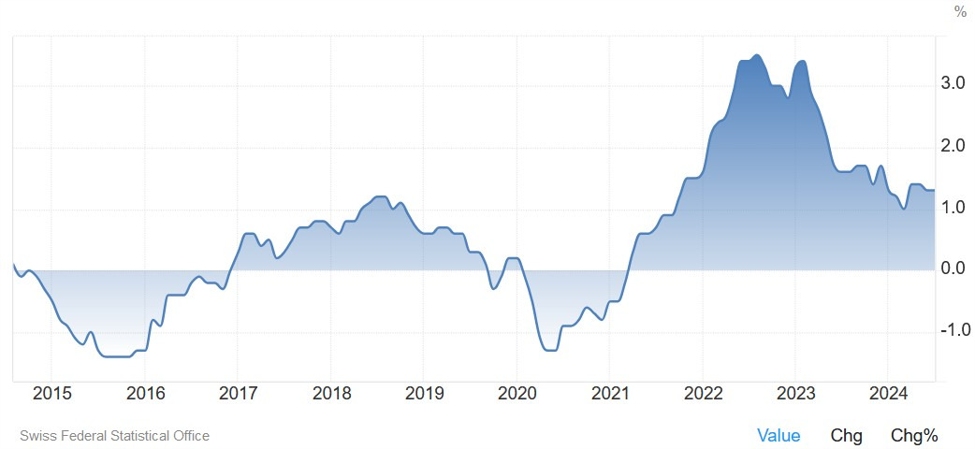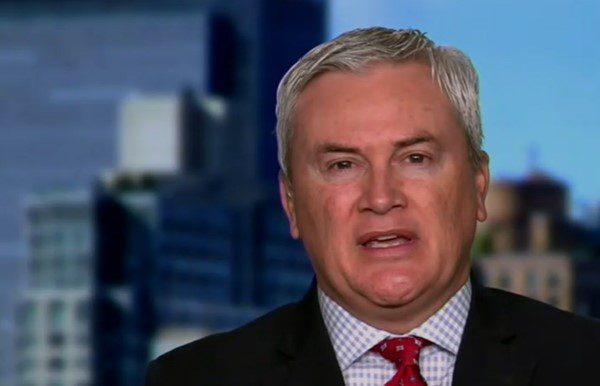UPCOMING
EVENTS:
- Monday: US/Canada Holiday, China Caixin Manufacturing
PMI, Swiss Manufacturing PMI. - Tuesday: Swiss CPI, Swiss Q2 GDP, Canada Manufacturing
PMI, US ISM Manufacturing PMI. - Wednesday: Australia Q2 GDP, China Caixin Services PMI,
Eurozone PPI, BoC Policy Decision, US Job Openings, Fed Beige Book. - Thursday: Japan Average Cash Earnings, Swiss Unemployment
Rate, Eurozone Retail Sales, US ADP, US Jobless Claims, Canada Services
PMI, US ISM Services PMI. - Friday: Canada Labour Market report, US NFP.
Tuesday
The Switzerland
CPI Y/Y is expected at 1.2% vs. 1.3% prior, while the M/M measure is seen at
0.1% vs. -0.2% prior. The market is expecting the SNB to deliver 52 bps of
easing by year end with a 67% probability of a 25 bps cut at the September
meeting (the remaining 33% is for a 50 bps cut).
SNB’s Jordan last week didn’t sound happy about the strong
appreciation in the Swiss Franc, so we might either see a 50 bps cut in
September or some intervention from the central bank to calm things down a bit.
Swiss CPI YoY
The US ISM
Manufacturing PMI is expected at 47.8 vs. 46.8 prior. As a reminder, the last month the ISM release was the catalyst that triggered a
huge selloff in risk assets as we got the “growth scare”.
The main
culprit might have been the employment sub-index falling to a new 4-year
low ahead of the NFP report which eventually triggered another wave of selling
as it came out weaker than expected across the board.
Later on, lots of
data in August showed that the weak data in July might have been negatively
affected by Hurricane Beryl, so that’s something that the market will look
at for confirmation.
The S&P Global Manufacturing PMI released two weeks ago wasn’t exactly comforting
though. The index saw the second consecutive contraction and the commentary
was pretty bleak.
The agency said “this
soft-landing scenario looks less convincing when you scratch beneath the
surface of the headline numbers. Growth has become increasingly dependent on
the service sector as manufacturing, which often leads the economic cycle, has
fallen into decline.”
“The manufacturing
sector’s forward-looking orders-to-inventory ratio has fallen to one of the
lowest levels since the global financial crisis. Employment fell in August,
dropping for the first time in three months”,
US ISM Manufacturing PMI
Wednesday
The BoC is
expected to cut rates by 25 bps bringing the policy rate to 4.25%. The recent CPI report showed some more easing in the underlying inflation
measures and the labour market data was pretty soft.
Overall, it
doesn’t look like the central bank will go for a 50 bps cut but it cannot be
completely ruled out. Including the September cut, the market expects a total
of 75 bps of easing by year end.
BoC
The US Job
Openings is expected at 8.100M vs. 8.184M prior. The last report saw a slight increase but the strong downtrend that
started in 2022 remains firmly in place. The quit, hiring and layoff rates
remain low as the labour market has been softening via less hiring rather than
more layoffs.
US Job Openings
Thursday
The Japanese
Average Cash Earnings Y/Y is expected at 3.1% vs. 4.5% prior. As a reminder,
the economic indicators the BoJ is focused on include wages, inflation,
services prices and GDP gap.
Moreover, Governor
Ueda kept the door open for rate hikes as he said that the recent market moves
wouldn’t change their stance if the price outlook was to be achieved and added
that Japan’s short-term interest rate was still very low, so if the economy were
to be in good shape, BoJ would move rates up to levels deemed neutral to the
economy.
Japan Average Cash Earnings YoY
The US Jobless
Claims continues to be one of the most important releases to follow every week
as it’s a timelier indicator on the state of the labour market.
Initial Claims
remain inside the 200K-260K range created since 2022, while Continuing Claims
have been on a sustained rise showing that layoffs are not accelerating and
remain at low levels while hiring is more subdued.
This week Initial
Claims are expected at 230K vs. 231K prior, while Continuing Claims are seen at
1865K vs. 1868K prior.
US Jobless Claims
The US ISM
Services PMI is expected at 51.1 vs. 51.4 prior. This survey hasn’t been giving
any clear signal lately as it’s just been ranging since 2022, and it’s been
pretty unreliable. The market might focus just on the employment sub-index
ahead of the US NFP report the following day.
The recent S&P Global Services PMI showed another uptick in the services sector as
growth in Q3 diverged again between Manufacturing and Services.
US ISM Services PMI
Friday
The Canadian
Labour Market report is expected to show 25.0K jobs added in August vs. -2.8K
in July and the Unemployment Rate to increase to 6.5% vs. 6.4% prior. It’s
unlikely that the market will care much about this report since we get the US
NFP released at the same time.
Canada Unemployment Rate
The US NFP is
expected to show 165K jobs added in August vs. 114K in July and the
Unemployment Rate to tick lower to 4.2% vs. 4.3% prior. The Average Hourly
Earnings Y/Y is expected at 3.7% vs. 3.6% prior, while the M/M figures is seen
at 0.3% vs. 0.2% prior.
The last month, the US labour market report came out weaker than
expected across the board and triggered another wave of selling in risk assets that
started with the ISM Manufacturing PMI the day earlier.
There’s been
lots of talk about the possible culprit for the weaker figures and it seems
like Hurricane Beryl affected the data.
The BLS said
Hurricane Beryl, which slammed Texas during the survey week of the July
employment report, had “no discernible effect” on the data.
The household
survey, however, showed 436,000 people reported that they could not report to
work because of bad weather last month, the highest on record for July. There
were 249,000 people on temporary layoff last month.
In fact, the
majority of the increase in the unemployment rate has been due to people on
temporary layoff. The market will want to see if July’s data was indeed
negatively affected by temporary factors.
As a reminder, the
Fed is very focused on the labour market now and this report will decide
whether they will cut by 25 bps or 50 bps at the upcoming meeting.
US Unemployment Rate















